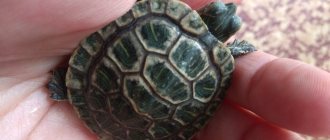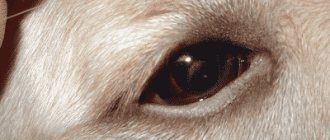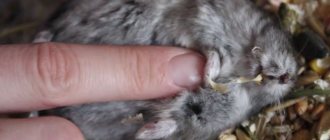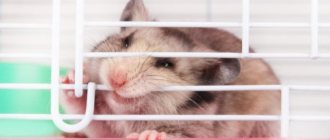Color
The first thing you should pay attention to when purchasing a small rodent is the color of its coat. Let's look at every detail of the color that helps determine the breed of the rodent.
- Dzhungarik's wool is colored in dark shades of brown, black and gray. The fur of its dwarf relative is colored in sand and amber shades; there are also black representatives of the species. If Djungarian hamsters are dark brown, the Campbell hamster has light shades of brown.
- In 99% of cases, Dzungarik has a diamond on his head. Depending on the color of the coat, it can be clearly outlined or almost merge with the main color of the coat. It is most clearly drawn on the head of brown rodents. In gray animals it is barely visible.
- Look at your pet's sides. Dzungariks have clearly defined arches between their back and stomach. The Campbells also have them, but their outlines are not so pronounced. They practically merge with the main color of the coat.
- The last thing to notice is the stripe on the back of the pygmy rodent. It is present in both breeds, but in Dzungariks it has clear boundaries, and it is also quite wide in the withers area. The Campbell's hamster has a thin dorsal stripe, almost invisible in the lower part of the body.
Campbell rodents come in a wider variety of colors. Among the pets there are albinos, animals with Argentine and Agouti colors, spotted and gray rodents, etc.
Age-related changes
If a hamster has a white spot on its eye, this indicates that the animal is beginning to undergo senile changes in its body. This disease is called cataracts and occurs in all mammals. It is caused by clouding of the lens. More often the eye becomes cloudy in the area of the pupil, less often along the periphery. At first the spot is gray, gradually turning white.
The development of cataracts in rodents is caused by stress, eye injuries, and sometimes the disease results from other ailments: diabetes mellitus in dzhungarik, food poisoning. The risk of cataracts increases if the animal's cage is regularly exposed to the sun.
Unfortunately, there is no cure for this eye disease in hamsters; it is impossible to get rid of it. But there are tips that will help significantly reduce the risk of developing the disease:
- Do not leave the animal's house in the sun.
- Don't give your home a lot of sweets.
- Make sure your diet is rich in carotenoids; they are found in carrots, parsley, zucchini and other foods of plant origin.
- Treat your animal's eye infections promptly.
In rare cases, furry cats have congenital cataracts. What to do if your pet has an eyesore? Hamsters don’t have very good eyesight anyway, but with this problem they can see completely poorly. Therefore, do not clutter the cage with furniture, as this can lead to injury.
Wool
The second point that is worth paying attention to is the appearance of the wool. Campbell's and Djungarian hamsters differ in the density of their fur. Dzungarik's coat is denser than his miniature relatives, smooth and even. Campbell's hamster, on the other hand, is covered in fur that gathers in clumps. The type of fur of this small rodent resembles the wool of a sheep; when the animal moves, it is divided into stripes. This difference in the appearance of the coat is due to the fact that in Dzhungarik it grows at a smaller angle to the body than in Campbell.
Body type
The Djungarian hamster and the Campbell breed have the same dimensions. Their body length does not exceed 10 cm. Accordingly, they belong to dwarf rodents. Smaller than them is only the Roborovsky hamster, whose body length does not exceed 6 cm.
If you look closely at the physique of miniature rodents, it has some differences. Campbell's hamster boasts a waist. Accordingly, if you look at the rodent from top to bottom, the body structure will resemble the figure 8. The Dzungarian dwarf rodent has a more rounded shape. When viewed from above, the shape of its body can be compared to an egg.
Breed characteristics
You need to start with one simple fact: red eyes in hamsters do not in all cases indicate an illness in the animals.
Moreover, many breeds of rodents have such eyes initially (more precisely, this is a consequence of selection work). In these cases, “redness” is just breed characteristics:
- Campbell's hamsters. Not all of them, but only some color varieties (light, including sandy and amber).
- Many other hamsters with gray, brown, white coloring, as well as in the “ivory” variants, have red eyes.
There are exceptions too. For example, among “jungarians” this coloring of the cornea is not found at all, with the exception of albinos. However, it is impossible to describe all possible breed variations within one article. If there are doubts related to the coat color and eye color of the animal, consultation with an experienced breeder is necessary.
In particular, there is a classic situation when the same Campbell hamsters are passed off as Djungarian hamsters. So, if in the first case animals have red eyes and this is allowed by breed standards, then in principle Djungarians cannot have red eyes.
Character
Kind and affectionate hamsters
Representatives of the breeds are radically different in character. The Dzungarian small rodent is restive and aggressive. He often bites people who try to pick him up, but with proper training he becomes gentle and affectionate. The main thing is to surround him with love and care. Your pet should be tamed gradually. It is important to explain to children that a pet is not a toy.
As for his dwarf relative, he rarely shows aggression towards adults and children, so you won’t have to spend a lot of time taming him. With a little care and patience, the owner will receive an affectionate pet that can easily fall asleep in his arms.
At the same time, we must not forget that each rodent has its own character, so within the same breed there are both aggressive and affectionate animals. The character of a dwarf rodent can be partially determined by its behavior in the pet store.
Rules for caring for albino hamsters
Caring for snow-white hamsters is almost no different from caring for other rodents. But there are several features in their content that should be taken into account so that the pet feels calm and comfortable:
- Animals with white coats do not like to be close to other hamsters, so it is advisable to keep them in a separate cage. This is especially true for miniature albino jungarians, who often show aggression towards other rodents;
- The owner will have to frequently change the bedding in the pet’s home to prevent infection from entering the animal’s sensitive eyes;
- Cage size is also important when keeping these unusual animals. The cage should be spacious and equipped with a running wheel, shelves at different levels and a swing;
- Snow-white rodents love secluded places where they can hide from everyone. For example, the albino Syrian hamster needs a house in which it spends most of the daytime, escaping the light and sun;
- Hamsters with snow-white fur should not be bathed. To make their coat look well-groomed, just put a bath with special sand in the cage;
- These animals are very shy, so it is necessary to protect them from noise and loud sounds. It doesn’t matter what breed your pet is, a miniature Djungarian hamster, or a fluffy snow-white Syrian, the main thing is to devote enough time and attention to your unusual pet, because each of them needs the love and care of the owner.
Red-eyed albino hamsters 5 (100%) 3 votes
Breed Features
Red eyes are considered normal only in hamsters of a certain coat color - white. They are similar in appearance to each other, but differ greatly from the usual pigmentation of the coat. The color is uniform, it does not have dark inclusions or other shades. Its snow-whiteness only emphasizes the redness of the eyeballs.
Below we will answer two of the most popular questions regarding the health of a small pet.
Why do albino hamsters have red eyes?
Sometimes it turns out that the most common rodent parents (in particular, Syrian hamsters) give birth to offspring whose fur has no pigmentation at all. The idea that albinos are a separate breed is erroneous. Such cubs are born among any breed. This is due to some genetic mutations, which in turn do not affect the behavior or health of hamsters.
Albino fluffies are considered very valuable representatives of the family, because it is almost impossible to breed them artificially. The uncharacteristic color is the result of the fact that the body of these rodents does not produce melanin, which is responsible for pigmentation. Because of this, blood vessels and capillaries are visible through the transparent membrane of the eyes.
It is quite difficult to meet albinos in the wild, because they fall prey to predators (their white color gives them away), but at home such a pet can live for about four years.
White hamsters with red eyes are slightly different from their relatives in size and character. The Djungarian albino hamster can be quite aggressive towards other representatives of the breed, while the Syrian is larger in size, but it easily gets used to hands and is unpretentious.
Why do hamsters have yellow teeth?
This question also worries the owners of these cute fluffies. This is not a disease, but a norm. Since rodents' teeth grow constantly, the animals have to grind them down on their own. Because of this, the protective layer of enamel on the incisors increases, making them stronger. The yellower the teeth, the stronger they are.
Rodents' teeth are not brushed, but every six months he needs to be taken to a dentist for a dental examination.
Albino hamsters: care and maintenance at home
Caring for a white hamster is no more difficult than caring for a dark one. Like any other hamster, an albino is a loner by nature. To make his stay at home comfortable, follow the following rules for caring for your animal:
- Do not put several animals in one cage. Pets must live separately from each other.
- Do not leave the cage with the dwarf in the bright sun. It can burn the skin and cause blindness in the animal.
- There should be no sources of sharp sounds near the pet. Loud noise causes stress in the dwarf, which causes him to lose his appetite, become restless and aggressive.
- Place a house in the rodent's cage where it will rest during the daytime. Change the cage bedding as often as possible. Dirt can get into your pet's eyes and cause irritation. It is best to use corn filler or compressed sawdust.
- Buy your animal items for an active lifestyle: toys, a running wheel, a small ladder. An albino needs a stone to grind down his incisors. The mineral is good for the health of the rodent, and its price is low.
- Change the water in the drinking bowl daily and remove leftover food.
- Don't bathe your rodent. Place a cup of sand in the cage so that the animal can clean its fur.
Caring for white hamsters, as well as their cost, is slightly different from the maintenance and price of ordinary hamsters.
What should you be wary of?
Hamster diseases can also answer the question - why does a hamster have red eyes. This applies to animals that do not initially have white fur, so it is necessary to take your pet to a veterinarian for examination.
In this case, treatment is most often required, because redness and swelling may indicate not only mechanical irritation, but also be a manifestation of diseases of other organs.
An obvious ailment is the animal's blindness - congenital or acquired. It can be diagnosed independently: the rodent moves little, and the eyes fester or swell. If you consult a doctor at the initial stage, vision can be restored with medication.
But this is not the only danger. The protrusion of the eyes of these animals causes infections to enter the body. Even walking through a dusty room or living in unkempt cages for hamsters causes conjunctivitis.
- eye redness and swelling;
- purulent discharge;
- drowsiness and lethargy of the animal.
Advice! Regular cleaning of premises will help avoid this inflammation.
Self-treatment without a medical examination can only worsen the situation. It is better to take care of your pet using other methods: clean the cage and wheel with antiseptic solutions and provide proper nutrition (whole grains and chicken meat). Use special eye drops at the prescribed time as prescribed by your veterinarian.
Here they are - breeds of hamsters with red eyes. If you were wary of them before, now you know that this is a rare gift, and you will be lucky enough to become the owner of an albino.
Conjunctivitis in hamsters: symptoms and treatment methods
Conjunctivitis is a familiar problem to everyone, but it affects not only people, but also pets. It needs to be treated at the first symptoms, because in a neglected state many more serious sores can be added, some of which can only be solved by surgical intervention.
The first symptom of conjunctivitis is considered to be wet eyes, then more serious troubles are added, such as:
- The hamster's eyes fester, the pus is characteristically green or yellow, especially in large quantities in the morning;
- The eyelids swell;
- The animal cannot fully open its eyes;
- The hamster becomes lethargic and refuses to eat.
Usually, for conjunctivitis, the veterinarian prescribes washing and instillation of the eyes with special drops. Also, a sick animal needs to be subject to some kind of quarantine. Isolate him from other animals that live in your home.
Additional tips regarding treating conjunctivitis in hamsters:
- Careful hygiene. Change the bedding daily, and wash your hands before putting drops in the animal’s eyes;
- Both eyes need to be treated, even if only one is sick;
- Monitor your pet's diet, excluding sweets;
Usually, conjunctivitis can be completely cured in two to three weeks. To avoid re-infection, try to keep the animal's cage clean and play with it after washing your hands.
It is important to know that untimely treatment of this infection can lead to your hamster's eye popping out. It will become unnaturally convex. This can only be corrected through surgery.
Albino hamster - what kind of animal?
The wild nature is not very suitable for the snow-white hamster - the albino is vulnerable to predators. For breeders and breeders, this feature is of great interest. The wool and skin of albinos is devoid of coloring pigments. Due to the mutation, the animals' eyes are red: a network of blood vessels is visible through the transparent iris (it has no melanin).
The mutation is not a disease, but it increases the susceptibility of albinos to stress. High-quality feeding, care and timely contact with veterinarians are the key to a long life for a pet.
Albino hamsters are not a separate species, but they can be any breed. The most common of them are described below.
- Djungarian hamster. Its homeland is the steppes of South-West Russia. Unpretentious and friendly individuals are ideal for home keeping; they are one of the most popular breeds for breeders with children. When handled with care, they do not show aggression, quickly get used to their owners, and are able to recognize them. However, they can show aggression towards cage neighbors. They are most active in the evening and at night.
They quickly explore the territory, stock up on food, and willingly participate in entertainment (play and run around in the wheel a lot). Monosaccharides are harmful to them due to the risk of diabetes. On average they live about 3 years.
- Campbell's hamster. This is a dwarf hairy-footed hamster native to the steppes of East and Central Asia. Its lifespan can reach 2 years. Campbell's albinos are highly aggressive and often bite their owners; sometimes you can only approach them with leather gloves. They are unpretentious in maintenance and are suitable for breeders without small children.
- Siberian (white Russian dwarf) hamster. Sociable representatives of the breed easily find a common language with children. Their body length reaches only 10 cm. They are silent animals that are easy to train.
Due to increased activity, this individual requires a spacious cage with entertainment devices. With good care, a domestic Siberian white hamster can live up to 4 years.
- Syrian hamster. Widespread companion animals of this breed live from 2 to 4 years, grow up to 15 cm. Docile, easily tamed individuals. They only get along poorly with each other: even if there are no signs of aggression, the animals experience stress when they do not live separately. These are social albinos - they require daily communication and become completely tame.
- Another interesting but rare breed is the “Roborovsky” hamster. These are incredibly fast moving individuals, social and very active. Their homeland is China and Mongolia. The smallest variety of albino hamster is characterized by a body length of 5 cm. The breeder will need a cage with frequent bars and increased attention.
Roborovsky hamsters get along well not only with their owners, but also with each other.
Why does a hamster have red eyes?
Hamsters are susceptible to various infections and age-related diseases.
Eye diseases are quite common among them. If you don’t know why the hamster doesn’t open its eye, look into this issue. This will help to heal the fluffy faster and avoid illnesses in the future. Here are the main reasons:
- Unsanitary conditions. The most common cause of eye infections in hamsters. In a filler that has not been changed for a long time, pathogenic microorganisms multiply at incredible speed. But homa likes to burrow into the litter, so the likelihood of picking up an infection is very high.
- Allergy. If you feed your pet all sorts of exotic foods, then don’t be surprised that your hamster’s eyes are watery. This is a common allergic reaction. Allergies can also be triggered by the chemicals you used to wash the cell.
- Injuries. Injuring the eyes of hamsters is not that difficult. The animal can prick its eye with hard hay or drive a piece of sawdust litter under the eyelid. But if a hamster has one eye closed, most likely the animal’s cheek is damaged: it is so swollen that the eye closes by itself.
- General decrease in immunity. It has been noted that conjunctivitis in hamsters is often accompanied by pneumonia, tuberculosis and viral diseases of the respiratory tract.
There are also senile changes in the organs of vision, in which white spots appear.
How can you tell if your Homa has problems with his eyes? It is necessary to examine the animal daily so as not to accidentally miss the disease. You should be concerned if:
- Hamsters' eyes are wet;
- swollen eyelids;
- mucous discharge from the eye appeared;
- the pet does not open its eyes or at least one of them;
- fur began to come out on the eyelids;
- The hamster's eye turned white in the pupil area.
Cloudiness of the pupil is typical for old animals, but other symptoms occur in pets of all ages. Most often they are caused by diseases of bacterial origin.
The opinion that hamsters with a snow-white coat and red eyes belong to a separate breed is erroneous. After all, albinos are found both among the Dzungarians and among representatives of the Syrian breed.
It is quite difficult to meet albino hamsters in natural habitats, since due to their light fur the animals are not adapted to survival and often become victims of predators.
To breed rodents with a white color, it took breeders several years of hard work, and such experiments did not always end successfully. The first white hamsters, bred artificially, were not distinguished by good health and long life expectancy. In addition, albinos behaved aggressively and often bit their owners when trying to pick them up.
Finally, after lengthy selection work, scientists managed to breed white hamsters that did not have serious health problems and had a friendly, peaceful character.
Miniature rodents with a dazzling snow-white coat and bright red eyes are quite rare even now, so they are especially valued by breeders and are popular among fans of unusual pets.
We suggest you read: Bald patches on a cat near the ears: the cat’s tail is bald
Infection
How to maintain?
Mutations can make white hamsters with red eyes susceptible to skin diseases. Scab, lichen, papillomas, dermatophytosis are common ailments, the progress and treatment of which should be monitored by a veterinarian.
Unusual eyes can be a weak point - an albino cannot be kept in direct sunlight to avoid blindness, eye disease and retinal damage. The skin of white hamsters is also vulnerable - even furry individuals are not immune to minor burns and must be able to hide from the sun and bright light. The hamster's cage should be located away from heating devices and in a place protected from drafts, but with good air circulation.
The snow-white coat of an albino requires special care. You can buy sand at the pet store that is suitable for baths. Water and sand must be provided to the animal; bathing them yourself is not recommended, since a healthy animal is able to take care of its cleanliness.
Albinos need solid food to wear down their teeth, which grow throughout their lives. You can buy special mineral stones. If the owner is confident in his skills, he can trim the hamsters' claws himself. They are also devoid of pigments and are light in color, so the procedure should be carried out with extreme caution.
Bulging eyes
This is more likely not a disease, but a consequence of injury to the eyeball, which has a bad effect on the general condition of the animal. A hamster can damage its eyes both in the fight against other rodents for survival and from dangerous objects contained in the cage - wood chips, sawdust, wire, etc.
As a result of injury, the invading pathogenic bacteria begins to rapidly multiply, penetrating even under the eyeball itself. Such a pet will most likely face surgery to remove the damaged organ. Otherwise, the bacterial infection can develop further, affecting the entire body. Then the rodent can no longer be saved.
We suggest you read: Why the gosling does not eat medicine for goslings
What should a house be like?
An albino's cage is where he will spend most of his life. It, like a person’s home, should be divided into sectors. In his home, the albino will eat, retire and rest, go to the toilet and be active.
Litter
The fairly common option of using newspapers and other paper is undesirable. Albinos tend to test the surrounding objects “by tooth”, and printing ink will not be useful for them.
At the same time, white hamsters with red eyes may be allergic to wood dust, so using clean, soft, dye-free wipes may be a solution. Hay is a good choice for bedding; some hamsters even make it their treat.
A common and convenient option is sawdust (it is important to ensure that there are no sharp chips or debris in them). Not only are they not harmful to an albino, but they also absorb moisture and odors. Cleanliness in the cage is important, first of all, for the pet itself. Wood filler is one of the most popular and environmentally friendly options - it holds odors for up to two weeks.
A convenient but expensive material is corn filler. It absorbs liquids as much as possible and maintains an excellent appearance.
Various fibrous bedding materials are contraindicated - most often cotton wool and fabrics. They can get into the cheek pouches of an albino, begin to rot and lead to inflammation. Threads are often wrapped around hamsters' paws - this can result in the loss of limbs.
All litter changes as it gets dirty. The toilet area is cleaned daily.
Different containers for food and water
To prevent the albino from turning over the bowl of water, you can purchase a special drinking bowl that is attached to the bars of the cage. The owner of the animal needs to carefully monitor its serviceability and filling.
It is necessary to clean containers for food and water without using chemicals - soda or tooth powder will do.
Items for activity
These include all kinds of running wheels, ladders and swings. Albinos are active at night. The less opportunity the owner has to frequently walk the hamster, the more conditions for the release of energy should be provided in the cage. In this case, you need to ensure that the albino’s paws do not get stuck between the bars or in the wheel.
It is necessary that the cage does not remain open when it is at height. Hamsters are not perfect with spatial thinking - the animal may attempt to escape, not feel the distance to the floor and fall from a height.
Place to rest
Pet stores sell special houses in which hamsters create a sleeping area using bedding. It is important to ensure that the hamster does not chew the house or try to swallow pieces of plastic or metal. Many hamsters enjoy relaxing in hanging hammocks.
Prevention of eye diseases
As you know, a disease is always easier to prevent than to treat.
By following some simple recommendations, you can reduce the risk of eye diseases in your pet to a minimum:
- Use a material for bedding that will not cause mechanical damage to the eyes and in which bacteria will not accumulate. Pet stores sell special litters; you can use odorless cat litter or wood litter.
- You should not keep many hamsters in one cage, as this can be dangerous.
- Separate from the rest of the hamsters those who have congenital diseases or are genetically predisposed to them.
- Do not place the cage in direct sunlight.
- Examine your pet's eyes regularly for signs of injury.
- Try to minimize or completely eliminate sweets from your diet.
What to feed?
The owner of an albino should not worry too much about his diet: a white hamster will eat the same things as his relatives. Ready-made foods based on wheat, oats and other grains are well suited, as well as sunflower and pumpkin seeds, corn, nuts, dried and fresh vegetables and fruits (carrots, beets, pears, raspberries, strawberries, peas, zucchini, apples). We must not forget about protein foods - an albino will happily enjoy boiled (but not fried) chicken and fish, eggs and shrimp.
Food is given twice a day in accordance with the weight and activity of the rodent - this must be monitored and overeating should be avoided to avoid obesity. Hamsters can and should be given vitamins and bought stones with minerals.
Albinos should not be given citrus fruits, spicy and exotic foods, garlic, or sweets. White cabbage is especially harmful for them; onions, salt, and mushrooms are contraindicated.
Small sizes do not save animals from big problems. If they occur (lethargy, suspicion of infection, hair loss, refusal of food and water, inability to independently cope with the growth of teeth), it is necessary to urgently contact a veterinarian.
If you treat keeping a hamster with full awareness of responsibility, he will keep company for as long as possible, delighting you with activity and good humor.
To learn how to care for a hamster, watch the following video.
Bacterial infections
If you notice that your hamster's eyes are festering, it means that your pet has picked up a bacterial infection. Its common pathogens are spherical and rod-shaped bacteria: staphylococcus, clostridium, E. coli, streptococcus, etc. Once under the eyelid, they begin to actively multiply. To fight them, the body sends protective cells - leukocytes, various enzymes and other substances that destroy the bacterial wall. As a result, pus is formed - a viscous substance containing living and dead bacteria.
There are several bacterial eye diseases. If your hamster's eye is festering, it could be one of the infections discussed below.
Conjunctivitis
The disease is not dangerous if left untreated. The disease in most cases is caused by pathogenic microflora and only occasionally has an allergic origin. First, the animal’s eyes begin to water; at this stage, few are able to recognize the disease. Then more reliable symptoms appear:
- The hamster's eye is rotting. Pus is a yellow or greenish mass that collects in the corners of the eye;
- the eyelids become inflamed and may swell;
- the palpebral slits narrow until the eye closes completely;
- the animal becomes apathetic and may lose appetite.
If a hamster's eyes fester, it is important to start treatment on time, since pathogenic flora can spread to the eyelids from the inside and outside, the hair will begin to come out, and the pet will be very uncomfortable. As a result of advanced conjunctivitis, the eyes may close completely, and this is a huge stress for the animal.
Few people know how to treat conjunctivitis in domestic rodents and whether it is possible to use a human first aid kit. Of course, it is better to make an appointment with your veterinarian to get professional advice. But if this is not possible, you will have to care for the fluffy yourself.
Doctors do not recommend smearing the eyes of rodents with tetracycline ointment. It is better to use Albucid drops, drip them three times a day. Treatment of hamsters, depending on the degree of neglect of conjunctivitis, will last from 3 days to 2 weeks.
Important points in treatment and prevention:
- A sick hamster should be isolated from healthy individuals if you have several rodents.
- Every eye of the animal is treated, even if suppuration is noticed in only one. This is done so that the animal does not transfer the infection from one eye to the other while washing.
- During conjunctivitis, it is better to change the litter daily.
- Eliminate sweets from the diet for a while, give only grains, nuts and unsweetened vegetables.
- To reduce the chance of eye infection, clean the cage frequently. Also make sure that children play with the hamster after washing their hands first.
Conjunctivitis cannot be left untreated; this will lead to the eye not opening at all, or, on the contrary, it may “pop out.”
Blepharitis
Usually a complication of conjunctivitis, with inflammation spreading to the eyelids. They turn red and itch terribly, the hamster rubs its eyes, which is why the hair quickly falls out. If you bring your pet with these symptoms to the veterinarian, he will tell you in detail why the hamster's eye is swollen. The doctor will tell you how to properly treat blepharitis.
We invite you to familiarize yourself with: Aquarium plants: photos with names and descriptions. What plants are best for an aquarium? Aquarium plants, live and artificial
Usually, in case of purulent inflammation of the eyelids, the same eye drops are prescribed as for conjunctivitis. In addition, it is recommended to smear the animal’s eyelids with tetracycline ointment. Sanitation and diet are also similar to those for conjunctivitis.
bulging eye
It happens that one eye of a homa becomes larger than the other and seems to stick out a little. If a hamster's eye pops out, this is a consequence of injury (for example, falling from a height) or an advanced infection. Conjunctivitis can spread not only to the eyelids. Bacteria can penetrate into or under the eyeball. There they begin to divide, a lot of pus is formed, which seems to squeeze the eye out.
The situation is very serious, you will not be able to cope with it on your own. The prognosis is also disappointing: in most cases, the animal is prescribed surgery to remove the organ of vision.
Sometimes the reason why a hamster's eyes won't open is due to other illnesses. For example, a severe inflammatory process in one of the cheek pouches. Because of this, the animal's cheek swells and props up the lower eyelid. As a result, the hamster is unable to fully open its eyes.
To help the animal, you should take it to the veterinarian for a cheek cleaning procedure. Eye drops and ointments are not needed at all.
The main condition for maintaining the health of your pet's eyes is cleanliness. Wash the cage often and do not touch the animal with dirty hands. But if your pet has an inflamed eye, treat it with special drops. Do not forget to isolate the sick rodent from a common cage if you have several hamsters, because eye diseases are very contagious.











